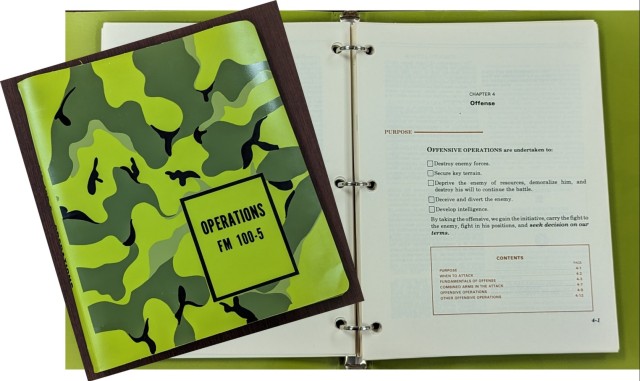U.S. Army Training and Doctrine Command’s 50th anniversary is July 1, 2023. In celebration, the TRADOC Communication Directorate in collaboration with the TRADOC Military History and Heritage Office, is sharing an article series highlighting key moments in TRADOC’s history to include the evolution of training, AirLand Battle, and gender integration.
One of the U.S. Army Training and Doctrine Command’s core responsibilities from its beginning has been to research, write, and publish the Army’s doctrine. This doctrine includes the manuals and handbooks on “how to fight.”
An early and significant task of TRADOC’s in the year of its establishment was to help the Army recover from the Vietnam War, which the command’s establishment had partly addressed. TRADOC also engaged to respond to a reinvigorated Soviet and Warsaw Pact threat to NATO that had arisen especially in Central Europe while the Army had focused its attention on operations in Southeast Asia. That recovery, lead by TRADOC’s doctrinal focuses, saw the Army through the transition of Active Defense to AirLand Battle.

Reimagining and refining the Army’s tactical and operational ways of war after Vietnam demanded much time from Gen. William E. DePuy, TRADOC’s first commanding general, and even his successors. While the focus was recovering from the Vietnam War, the world was witnessing the short and extra lethal Yom Kippur War in October, known as the Fourth Arab-Israeli War, pitting Arab coalition armies using Soviet doctrine and weapons against the Israeli Defense Force using U.S. doctrine and weapons. Particularly concerning to the Army was the Yom Kippur War’s high degree of materiel destruction of weaponry and supporting systems on the battlefield. To the U.S. military, that war seemed to foreshadow what might occur should the large Red Army and Soviet-bloc forces attack the less numerous NATO and U.S. Army forces in Central West Germany.
One response to the Yom Kippur War was the Army’s effort to recast its capstone operational doctrine, Field Manual 100-5 Operations, to account for the likelihood that Soviet and Warsaw Pact forces would initially heavily outnumber U.S. and NATO forces in the event of a next European war. That FM traced its origins to the Army’s publication of Field Service Regulations 100-5 in 1905 as part of the service’s reform efforts following the 1898 Spanish-American War. From 1905 through 1968, the Army had published 11 different versions of FSR/FM 100-5.
Starting soon after TRADOC’s establishment, its commander, DePuy, and Maj. Gen. Paul F. Gorman, deputy chief of staff for training, assisted by a small brain trust of mostly field-grade officers known informally as the “boathouse gang” after a former Ft. Monroe, Va. yacht club building where they met, produced the July 1976 edition of FM 100-5 Operations, which also was part of an America military-wide doctrinal renaissance following the Vietnam War. A creature as well of its Cold War context, the 1976 version of FM 100-5 suggested the Army and its NATO allies would fight outnumbered. Additionally, though expected to be outnumbered, the Army must still win the first battle of the next war against an armor-heavy Soviet and Warsaw Pact in Central Europe by focusing on tactical maneuver and overwhelming battlefield firepower in what came to be known as Active Defense. Since at least the time of Lt. Gen. Ulysses S. Grant’s command of the Union army during the last year of the Civil War, the Army had focused on the offensive and incapacitation of the enemy in decisive battle.

Critics of Active Defense ridiculed it as contrary to the primary historical strength of the Army—the offense. Under the direction of the second TRADOC commander, Gen. Donn A. Starry, and reaching completion under its third commander, Gen. Glenn K. Otis, the Army, with TRADOC again leading, finished yet another doctrinal reform. This one returned the service, once more, to the kind of offensive mindedness that had served it well on earlier European battlefields during the world wars. The product of that effort was AirLand Battle.
